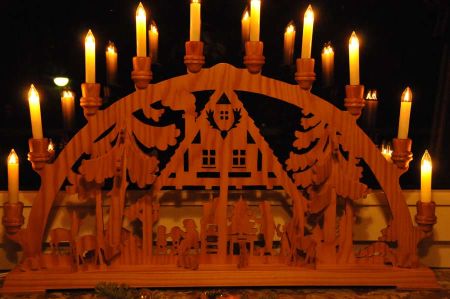Schwibbogen - the origin of the arc of lights
- Written by Portal Editor
We noticed the so called "Schwibbogen" for the first time during a vacation trip in the cute town of Altenau in the Harz Mountains, a formerly free mining town with its ancient miner houses that today is the picturesque background of the climatic health resort.
During a tour through the town in the 70s of the last century we had stumbled upon a small company, who had made a name with wooden handicrafts, a typical raw and natural material in the region, you will find in the construction of the houses as well. As another sample in the village you may visit the relatively small wooden church of St. Nicholas, which was built in the 17th century, completely from wood. The still most imposing wooden church stands in Clausthal-Zellerfeld, just a few kilometers away from Altenau. The houses in Altenau are well adapted from time immemorial the harsh winters and have a typical architectural style for the region.
But turning back to our tiny shop of wooden handicrafts, in addition to a variety of figures, we noticed the light bows at that time that were offered in different variations as a Christmas decoration. In its basic form a laminated sheet was cut as an arc design by a jigsaw, as well as the tiny figures. The arch itself was equipped with candle holders, wherein up to 12 candles beam different effects of light and shadow formation generated by the figures below by their light. It is beautiful to look at the many characters in the sheet itself, most striking detail were the hammers, which were used as a symbol in almost all arches. Because of that the origin of the light arcs lies in the mining industry, as many believe.
Of course we asked for it and learned from the different interpretations that had emerged over the years. So we discussed about it, that the shape of the arch is symbolizing the opening of a mine, then another opinion again that it means a celestial arc of the sun, moon and stars. The patch on the arc lights was an expression of the longing of miners after daylight, which in the winter months, they often did not get to face especially over weeks due to starting work early in the morning it was still dark, and after the end of the shift in the evening the sun had already set. The symbols used indicate that the motifs depicted in arches reflect the everyday life of the miners and their families.
One of the most famous motifs shows different icons next to two miners, a carver and a lace maker and thus embodies the three main sources of income of the rural population during the 18th and 19th century the Erzgebirge. Other variations show Christian motifs from the Christmas story or the forest and its animals. Another known design is the Church of the famous town Seiffen wellknown for its folk art in the Erzgebirge.
Today the arches are primarily for Advent and Christmas season, with electric lighting in general, in the windows of many houses, also made far outside the Erzgebirge region and find as large sheets even used outdoors. Currently the largest outdoors arch in the world was erected 2012 in Johanngeorgenstadt. The lighted candle arch in the private home windows as another symbolism is connected to daily life in many miners villages: the light of the candle arch should help the miners safe way back into the home.
The oldest known flying buttress, dates back to 1740, was found in Johanngeorgenstadt and is made of metal. In 2003 it was discovered under a younger layer of paint. Previously it had been assumed that the sheet with the inscription "1778" and "J. C. Plates "was found in its original livery. Other early Schwibbögen originate from 1796 to 1810.
After the Second World War, the arches were increasingly made of wood. As the demand in the GDR was greater than the supply, candle arches were often made privately as a fretwork along the lines of a traced template which then spread increasingly, similar to the small town of Altenau. The arc of light appearing in the picture, shows the sawing and modeling work of a carpenter from the 60s of the previous century, Karl-Heinz Rosendahl from Friesland, next to the North Sea, were this tradition was spread to over the years.
Please read as well:
